Great Seal of the United States
| Great Seal of the United States | |
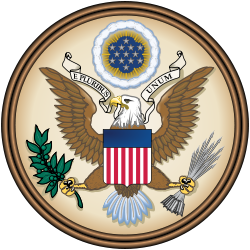 |
|
| Versions | |
|---|---|
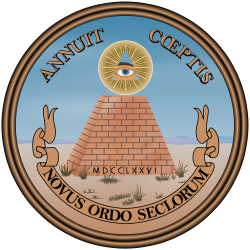
Reverse of the Seal
|
|
| Details | |
| Armiger | The United States of America |
| Adopted | 1782 |
| Crest | Thirteen mullets of five points arranged to form a mullet of six points surrounded by a glory proper. |
| Escutcheon | Paleways of 13 pieces, argent and gules; a chief, azure |
| Supporters | A Bald Eagle displayed |
| Motto | E pluribus unum |
| Other elements | In the eagle's dexter talon an olive branch of thirteen leaves and thirteen olives; in its sinister talon thirteen arrows; in its beak, a white label bearing the motto; the reverse bears "A pyramid unfinished. In the zenith an eye in a triangle, surrounded by a glory, proper." |
| Use | On United States passports (variant) |
The Great Seal of the United States is used to authenticate certain documents issued by the United States federal government. The phrase is used both for the physical seal itself (which is kept by the United States Secretary of State), and more generally for the design impressed upon it. The Great Seal was first used publicly in 1782.
The design on the obverse of the great seal is the national coat of arms of the United States.[1] It is officially used on documents such as United States passports, military insignia, embassy placards, and various flags. As a coat of arms, the design has official colors; the physical Great Seal itself, as affixed to paper, is monochrome.
Since 1935, both sides of the Great Seal appear on the reverse of the one-dollar bill.
Contents |
Design
Obverse

The main figure on the obverse (or front) of the seal is the coat of arms of the United States, a bald eagle with its wings outstretched (or "displayed," in heraldic terms). From the eagle's perspective, it holds a bundle of 13 arrows in its left talon, (referring to the 13 original states), and an olive branch, in its right talon, together symbolizing that the United States of America has "a strong desire for peace, but will always be ready for war." (see Olive Branch Petition). Although not specified by law, the olive branch is usually depicted with 13 leaves and 13 olives, again representing the 13 original states. The eagle has its head turned towards the olive branch, said to symbolize a preference for peace. In its beak, the eagle clutches the motto E pluribus unum ("Out of Many, One"). Over its head there appears a "glory" with 13 mullets (stars) on a blue field. In the current (and several previous) dies of the great seal, the 13 stars above the eagle are arranged in rows of 1-4-3-4-1, forming a six-pointed star.
The shield the eagle bears on its breast, though sometimes drawn incorrectly, has two main differences from the American flag. First, it has no stars on the blue chief (though other arms based on it do: the chief of the arms of the United States Senate may show 13 or 50 , and the shield of the 9/11 Commission has, sometimes, 50 mullets on the chief). Second, unlike the American flag, the outermost stripes are white, not red; so as not to violate the heraldic rule of tincture.
The 1782 resolution of Congress adopting the arms, still in force, legally blazoned the shield as "Paleways of 13 pieces, argent and gules; a chief, azure." As the designers recognized, this is a technically incorrect blazon under traditional English heraldic rules, since in English practice a vertically striped shield would be described as "paly," not "paleways," and it could not be striped of an uneven number. A more technically proper blazon would have been argent, six pallets gules... (six red stripes on a white field), but the phrase used was chosen to preserve the reference to the 13 original states.
Reverse

The 1782 resolution adopting the seal blazons the image on the reverse as "A pyramid unfinished. In the zenith an eye in a triangle, surrounded by a glory, proper." The pyramid is conventionally shown as consisting of 13 layers of blocks to refer to the 13 original states. There are also 13 sides shown on the ribbon. The adopting resolution provides that it is inscribed on its base with the date MDCCLXXVI (1776) in Roman numerals. Where the top of the pyramid should be, the Eye of Providence watches over it. Two mottos appear: Annuit Cœptis signifies that the Eye of Providence has "approved of (our) undertakings."[2] Novus Ordo Seclorum, freely taken from Virgil, means "a new order of the ages." It is incorrectly rendered as "New World Order" by some theorists, and "a new secular order" by others. The word seclorum does not mean "secular," as one might assume, but is the genitive (possessive) plural form of the word saeculum, meaning (in this context) generation, century, or age. Saeculum did come to mean "age, world" in late, Christian, Latin, and "secular" is derived from it, through secularis. However, the adjective "secularis," meaning "worldly," is not equivalent to the genitive plural seclorum, meaning "of the ages."[3]. The reverse has never been cut (as a seal) but appears, for example, on the back of the one-dollar bill.
The Eye of Providence, or "all-seeing eye," was a well-known classical symbol of the Renaissance. The eye in a triangle design originally was suggested by Pierre Eugene du Simitiere, and later heraldist William Barton improved upon the design. In Du Simitière's original sketch, two figures stand next to a shield with the all-seeing pyramid above them. The August 20, 1776 report of the first Great Seal Committee describes the seal as "Crest The Eye of Providence in a radiant Triangle whose Glory extends over the Shield and beyond the Figures."
Abstract of all elements counting 13
In honor of the fact that there were originally 13 states in the Union, items consisting of this number is a common motif in the seal. There are:
- 13 stars (in the "glory" above the eagle's head)
- 13 stripes on the shield
- 13 arrows in the eagle’s talon
- 13 letters in the mottos "e pluribus unum" and "annuit cœptis" (apparently coincidental; there are 52 characters on the whole seal, which is itself evenly divisible by 13)
- 13 olive leaves (by custom, not by law)
- 13 olives on the branch (by custom, not by law)
- 13 brick levels of the pyramid (by custom, not by law)
- 13 sides showing on the ribbon (by custom, not by law)
History
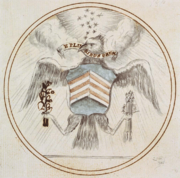
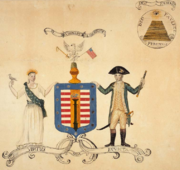
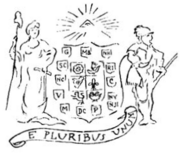
On July 4, 1776, the same day that independence from Great Britain was declared by the thirteen states, the Continental Congress named the first committee to design a Great Seal, or national emblem, for the country. Similar to other nations, The United States of America needed an official symbol of sovereignty to formalize and seal (or sign) international treaties and transactions. It took six years and three committees in order for the Congress to agree on a design.
The first of these committees consisted of Benjamin Franklin, Thomas Jefferson, and John Adams. Each of these men proposed a design for the seal. Franklin chose an allegorical scene that demonstrated the motto, "Rebellion to Tyrants is Obedience to God," where there is a depiction of the biblical story of the Exodus, when the Children of Israel are confronted by Pharaoh and achieve their liberation from slavery in Egypt. Jefferson suggested a depiction of the Children of Israel in the wilderness, led by a cloud by day and a pillar of fire by night for the front of the seal; and Hengest and Horsa, the two brothers who were the legendary leaders of the first Anglo-Saxon settlers in Britain, for the reverse side of the seal. Adams chose the painting known as the "Judgment of Hercules" where the young Hercules must choose to travel either on the flowery path of self-indulgence or the rugged, more difficult, uphill path of duty to others and honor to himself. Congress ultimately chose none of these initial designs.[4] An additional design was submitted by a consultant to this committee, Pierre Du Simitière, and two design elements of in his design appear in the final design (the "Eye of Providence" and the motto E Pluribus Unum - Out of Many, One).[5]
Two other committees were formed, but they too could not agree on a final design. Finally the problem was turned over to Charles Thomson, the Secretary of the Congress, who merged elements from all three previous attempts. Congress finally approved Thomson's integrated design on June 20, 1782, still in use today; and had it engraved into brass matrices, which were about 2.25 inches in diameter.
On September 16, 1782 Thomson used these matrices for the first time, to verify signatures on a document that authorized George Washington to negotiate an exchange of prisoners. Thomson took care of the Seal until the U.S. Constitution installed the new federal government in 1789, when he passed it over to the Secretary of State, Thomas Jefferson. All subsequent Secretaries of State have been responsible for applying the Seal to diplomatic documents.
The first matrices of the seal were replaced in 1841 when they became too worn to be effective.
There have been a total of seven re-engravings of the Seal since the original, which is now on display in the National Archives in Washington, D.C.
Symbolism
The only official explanation of the symbolism of the great seal was given by Charles Thomson upon presenting the final design for adoption by congress. He wrote:
The Escutcheon is composed of the chief & pale, the two most honorable ordinaries. The Pieces, paly, represent the several states all joined in one solid compact entire, supporting a Chief, which unites the whole & represents Congress. The Motto alludes to this union. The pales in the arms are kept closely united by the chief and the Chief depends upon that union & the strength resulting from it for its support, to denote the Confederacy of the United States of America & the preservation of their union through Congress.
The colours of the pales are those used in the flag of the United States of America; White signifies purity and innocence, Red, hardiness & valor, and Blue, the colour of the Chief signifies vigilance, perseverance & justice. The Olive branch and arrows denote the power of peace & war which is exclusively vested in Congress. The Constellation denotes a new State taking its place and rank among other sovereign powers. The Escutcheon is born on the breast of an American Eagle without any other supporters to denote that the United States of America ought to rely on their own Virtue.
Reverse. The pyramid signifies Strength and Duration: The Eye over it & the Motto allude to the many signal interpositions of providence in favour of the American cause. The date underneath is that of the Declaration of Independence and the words under it signify the beginning of the new American Æra, which commences from that date.[6]
Speculation
Some conspiracy theorists believe the eye atop the pyramid to have its origins in Masonic iconography[7], however this cannot be established. This idea is usually countered with the fact that the Eye of Providence motif has historically been employed for a wide variety of purposes and groups, and was particularly popular in the late 18th century, in Europe as well as America. In fact, it seems not to have been adopted as a masonic symbol until 1797, several years after the Great Seal of the United States had already been designed[8].
Furthermore Benjamin Franklin was the only Mason among the various Great Seal committees, and his ideas were not adopted.[9] Of the four men whose ideas were adopted, neither Charles Thomson, Pierre Du Simitière (usually credited with first suggesting this element) nor William Barton were masons and, while Francis Hopkinson has been alleged to have had masonic connections, there is no firm evidence to support the claim.[10][11].
Current seal
The obverse side of the Great Seal is used to emboss the design on international treaties and other official United States Government documents. It is stored in the Exhibit Hall of the U.S. Department of State inside a locked glass enclosure. An officer from the State Department does the actual sealing of documents after the U.S. Secretary of State has countersigned the President's signature. It is used approximately 2,000 to 3,000 times a year.
See also
- Confederate Seal
- Seal of the President of the United States
- Seal of the United States Senate
References
- ↑ American Heraldry Society | Official / The Arms of the United States: Criticisms and Rebuttals
- ↑ Journals of the Continental Congress, June 20, 1782
- ↑ Lewis and Short, A Latin Dictionary: Founded on Andrews' Edition of Freund's Latin Dictionary: Revised, Enlarged, and in Great Part Rewritten by Charlton T. Lewis, Ph.D. and Charles Short, LL.D. The Clarendon Press, Oxford, 1879, s. vv.
- ↑ www.greatseal.com page on the first committee
- ↑ www.greatseal.com page on De Simitière's design
- ↑ [http://www.greatseal.com/symbols/explanation.html as quoted by greatseal.com
- ↑ www.masoncode.com
- ↑ Masonic Dollar?
- ↑ Hodapp, Christopher; Freemasons for Dummies, Wiley Publishing, 2005, pp 155-156
- ↑ the Masonic Service Association
- ↑ Patterson, Richard S.; Richardson Dougall (1976). The Eagle and the Shield: a History of the Great Seal of the United States. Department of State, Office of the Historian, Bureau of Public Affairs. pp. 529. http://www.greatseal.com/mythamerica/notmasonic.html.
External links
|
|||||||||||||
|
||||||||||||||
